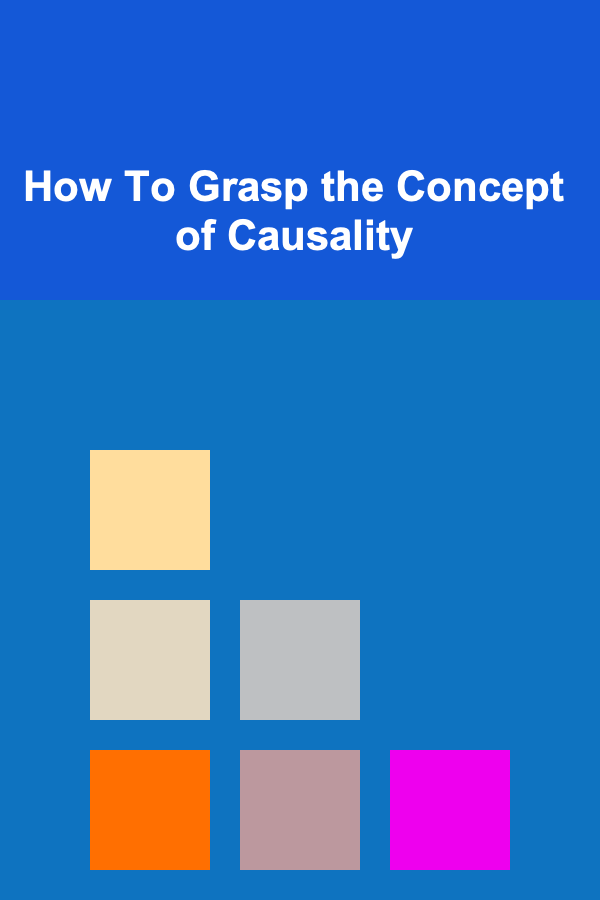
How To Grasp the Concept of Causality
ebook include PDF & Audio bundle (Micro Guide)
$12.99$5.99
Limited Time Offer! Order within the next:

Causality is one of the fundamental principles that governs our understanding of the world. It forms the basis of how we explain events, predict outcomes, and make decisions. Whether in philosophy, science, or everyday reasoning, causality plays a central role in how we interpret relationships between events. However, the concept of causality is more complex than it first appears. It encompasses a range of ideas, from simple cause-and-effect to intricate interdependencies that span multiple factors and levels of reality.
This article seeks to explore the concept of causality from various perspectives, including its philosophical origins, its application in science, and the challenges involved in truly grasping the nature of cause and effect. Through examining causality's historical development, its implications in various fields, and how we can conceptualize it in our own lives, we aim to provide a deeper understanding of this crucial concept.
The Roots of Causality
Causality has been a central topic in philosophy for thousands of years. Its origins can be traced back to early Greek thinkers such as Aristotle, who distinguished four types of causes:
- Material Cause: The physical substance or materials from which something is made.
- Formal Cause: The design or blueprint that defines what a thing is.
- Efficient Cause: The agent or process that brings about change or motion.
- Final Cause: The purpose or goal for which something exists.
Aristotle's framework was an attempt to explain how change occurs in the world and why things happen. His view of causality was comprehensive, taking into account not just the immediate cause but also the underlying purpose behind the existence of things. In this sense, causality was not simply a mechanical relationship between two events but a multifaceted concept that included a deeper teleological perspective.
Over time, these ideas evolved. The notion of causality was further refined during the Enlightenment by thinkers like David Hume. Hume famously challenged the traditional understanding of causality by arguing that we cannot directly observe cause-and-effect relationships. Instead, he proposed that we infer causality based on the regular succession of events. According to Hume, we see one event consistently following another, and from this pattern, we mentally infer that one event causes the other.
This shift from a philosophical to a psychological view of causality has had profound implications, shaping how we think about cause and effect today.
The Role of Causality in Science
In the modern era, causality is foundational to scientific inquiry. The scientific method relies on the ability to establish causal relationships between variables, as this allows researchers to understand the underlying mechanisms that drive phenomena.
Causality in Experimental Research
The cornerstone of experimental science is the ability to establish a causal link between an independent variable and a dependent variable. This is often done through controlled experiments, where researchers manipulate one variable (the cause) and observe the effects on another variable (the effect). The classic example is the medical experiment where a researcher administers a drug (the cause) to study its effects on health outcomes (the effect).
To demonstrate causality, three criteria must generally be met:
- Temporal Precedence: The cause must occur before the effect.
- Covariation: There must be a correlation between the cause and the effect.
- No Plausible Alternative Explanation: The relationship between cause and effect cannot be explained by other variables.
These three criteria form the basis of most experimental designs and provide a systematic approach to discerning causal relationships in the world.
Causality in Non-Experimental Settings
While controlled experiments are the gold standard for establishing causality, they are not always feasible or ethical. In such cases, scientists must rely on observational studies or natural experiments. These studies seek to infer causal relationships from data that is not controlled by the researcher. This approach is commonly used in fields such as economics, epidemiology, and social science.
However, inferring causality from observational data is fraught with challenges. One of the main issues is the presence of confounding variables---variables that influence both the cause and the effect. For example, if we observe a correlation between increased physical exercise and improved health outcomes, we cannot immediately conclude that exercise is the sole cause of the health benefits. There may be other factors, such as diet or genetics, that also play a role. Researchers must use statistical techniques like regression analysis or randomized control trials to address confounding and strengthen causal inferences.
Causality in Complex Systems
In complex systems, causality is often not straightforward. In fields such as climate science, economics, and biology, multiple variables are interrelated in complex ways, and cause-and-effect relationships are often non-linear and feedback-driven. For instance, in climate change research, increased carbon emissions may lead to higher temperatures, which then lead to more emissions due to the melting of ice caps and the release of methane from permafrost. This kind of feedback loop complicates the identification of clear, one-way causal relationships.
Moreover, complex systems often exhibit emergent properties, where the collective behavior of a system cannot be predicted solely from the behavior of its individual components. In such systems, causality must be understood at multiple levels, and the focus shifts from finding simple cause-and-effect chains to understanding how different factors interact within the system.
Challenges in Understanding Causality
Grasping the concept of causality is not without its difficulties. Beyond the philosophical and scientific complexities, there are several psychological and cognitive challenges involved in understanding cause and effect.
Cognitive Biases in Causal Inference
Human beings are prone to cognitive biases that affect how we perceive causality. One common bias is confirmation bias , where we selectively seek out information that supports our existing beliefs about cause and effect. Another bias is post hoc fallacy, where we assume that just because one event follows another, the first event must have caused the second. This bias can lead to faulty reasoning, especially in situations where multiple factors contribute to an outcome.
For example, if someone begins taking a vitamin supplement and then experiences improved energy levels, they may mistakenly attribute their increased vitality to the supplement, without considering other factors such as lifestyle changes or placebo effects.
The Problem of Determinism vs. Free Will
One of the most profound debates surrounding causality is the tension between determinism and free will. If all events have causes, can we truly be free to make our own choices, or are our actions merely the result of prior causes? This question has been explored for centuries, and different schools of thought offer differing views. Some, like determinists, argue that the universe operates according to unbreakable laws of cause and effect, leaving little room for free will. Others, such as libertarians, argue that humans have the ability to act independently of causal chains.
This philosophical issue complicates our understanding of causality because it challenges the idea that the future is entirely determined by the past. Some modern views, such as those found in quantum mechanics, suggest that there may be indeterminacies in the causal structure of the universe, opening the door for a more nuanced understanding of cause and effect.
Causal Complexity in Human Systems
Humans are particularly complicated systems, and understanding causality in human behavior is notoriously difficult. Psychological, social, and environmental factors all contribute to our actions and decisions, making it difficult to pinpoint exact causes for any given behavior. For example, the decision to engage in a particular social activity may be influenced by a myriad of factors, including personal preferences, societal norms, and situational context.
Additionally, human beings are often aware of the causes of their own behavior, but their explanations are sometimes influenced by subjective interpretations or unconscious motives. This adds a layer of complexity to how we understand human causality compared to physical or biological systems.
How to Grasp the Concept of Causality
Understanding causality is not just about learning a set of principles or criteria; it is about developing a mindset that allows you to recognize and navigate complex cause-and-effect relationships in the world. Here are some strategies for grasping causality more effectively:
1. Engage with Philosophy and Logic
To deepen your understanding of causality, start by engaging with philosophical discussions and logical reasoning. Learning about classical and modern philosophical views on causality can help you appreciate the historical context and different interpretations of cause and effect. Additionally, logic and critical thinking skills can help you evaluate causal claims more rigorously and avoid common fallacies.
2. Analyze Real-World Examples
Practice identifying causal relationships in real-world situations. Whether it's understanding the cause of a medical condition, analyzing economic trends, or evaluating a historical event, looking for cause-and-effect patterns in the world around you can help you apply theoretical knowledge to practical situations.
3. Study Scientific Methods
Understanding how scientists approach causality can also be valuable. Learn about experimental design, statistical methods, and research techniques that allow scientists to establish causal links. This will give you a clearer understanding of how evidence is gathered and interpreted in different fields.
4. Consider Multiple Perspectives
Causality is not always linear or simple. To truly grasp it, consider multiple perspectives when analyzing cause-and-effect relationships. Look at different levels of explanation, consider potential confounding factors, and be open to the idea that causality may involve feedback loops, emergent properties, or even indeterminacy in some cases.
5. Acknowledge the Limits of Causality
Finally, accept that causality may not always provide definitive answers. In some situations, it may be impossible to identify a single cause for an event, especially in complex systems. In these cases, acknowledging the limits of causality and adopting a more probabilistic or systems-based approach can lead to a more accurate understanding of the world.
Conclusion
Causality is a cornerstone of human reasoning, scientific inquiry, and philosophical exploration. While grasping the full complexity of cause and effect may be challenging, it is essential for understanding the world and making informed decisions. By engaging with the philosophical, scientific, and psychological dimensions of causality, and by practicing critical thinking and analytical skills, you can develop a deeper and more nuanced understanding of this fundamental concept. Through this understanding, we not only gain insight into the past and present but also better navigate the uncertainties of the future.

How to Create a Holiday Playlist for the Perfect Atmosphere
Read More
How to Personalize Your Own Corner in a Shared Room
Read More
How to Use Magnetic Strips for Utensil Storage
Read More
How to Budget for Travel
Read More
How to Tie Dye with Shimmer & Metallic Colors
Read More
10 Tips for Estate Planning: A Lawyer's Checklist
Read MoreOther Products

How to Create a Holiday Playlist for the Perfect Atmosphere
Read More
How to Personalize Your Own Corner in a Shared Room
Read More
How to Use Magnetic Strips for Utensil Storage
Read More
How to Budget for Travel
Read More
How to Tie Dye with Shimmer & Metallic Colors
Read More